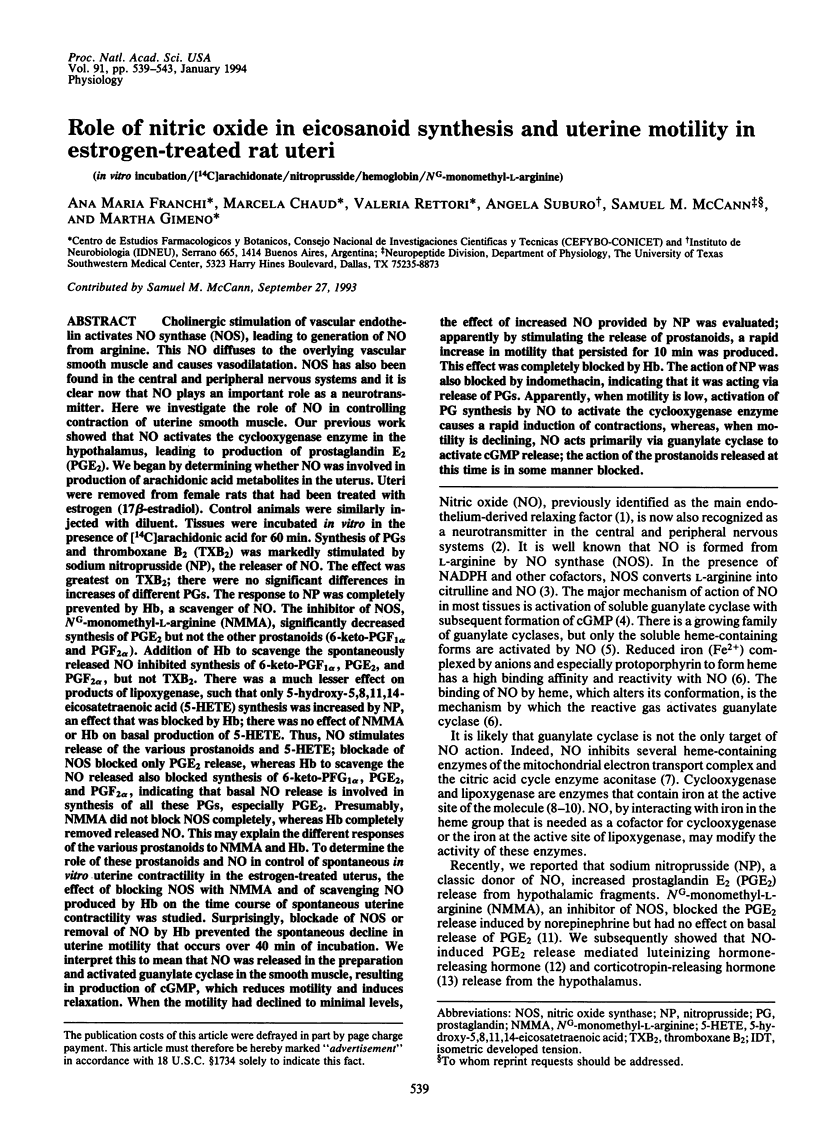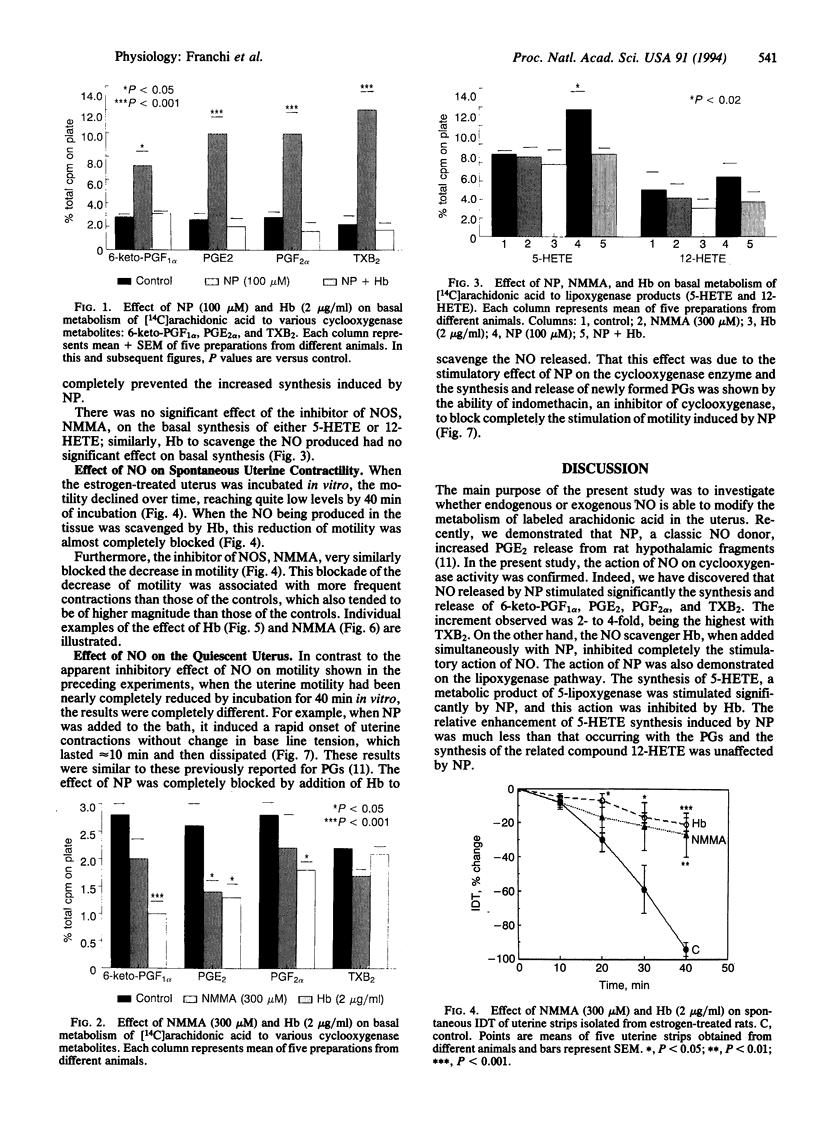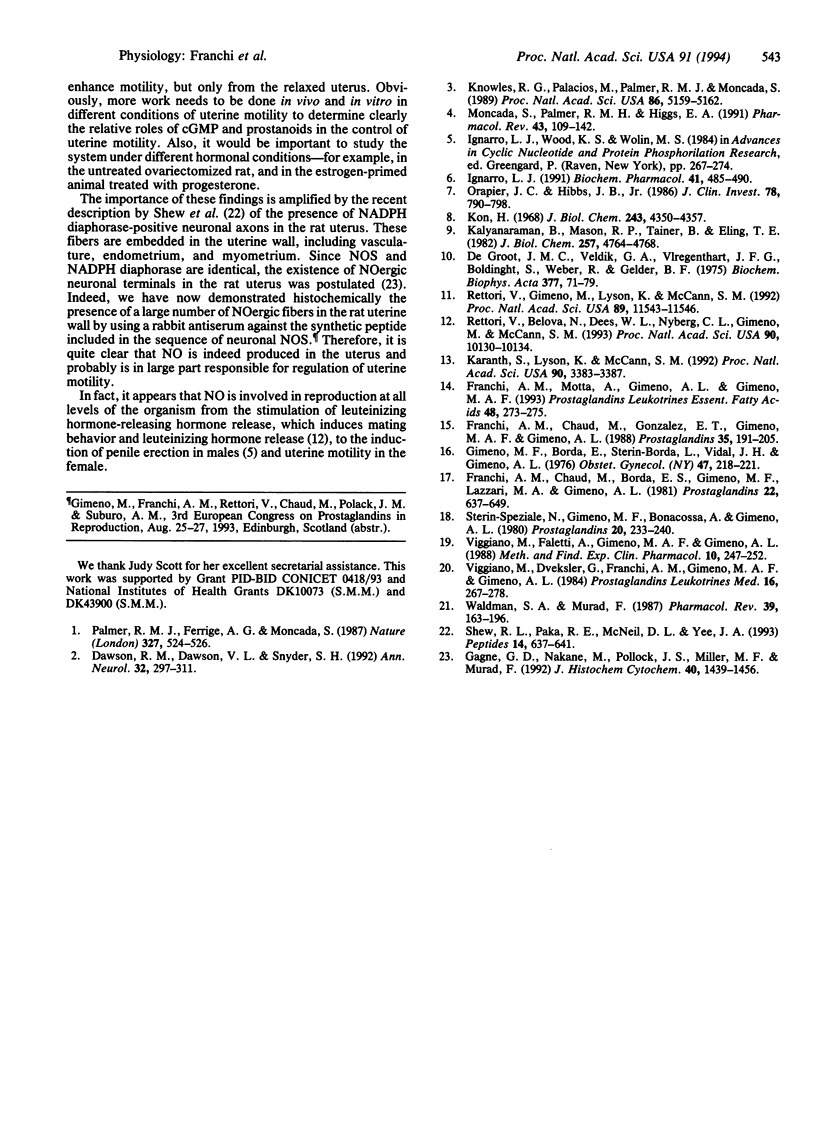Abstract
Cholinergic stimulation of vascular endothelin activates NO synthase (NOS), leading to generation of NO from arginine. This NO diffuses to the overlying vascular smooth muscle and causes vasodilatation. NOS has also been found in the central and peripheral nervous systems and it is clear now that NO plays an important role as a neurotransmitter. Here we investigate the role of NO in controlling contraction of uterine smooth muscle. Our previous work showed that NO activates the cyclooxygenase enzyme in the hypothalamus, leading to production of prostaglandin E2 (PGE2). We began by determining whether NO was involved in production of arachidonic acid metabolites in the uterus. Uteri were removed from female rats that had been treated with estrogen (17 beta-estradiol). Control animals were similarly injected with diluent. Tissues were incubated in vitro in the presence of [14C]arachidonic acid for 60 min. Synthesis of PGs and thromboxane B2 (TXB2) was markedly stimulated by sodium nitroprusside (NP), the releaser of NO. The effect was greatest on TXB2; there were no significant differences in increases of different PGs. The response to NP was completely prevented by Hb, a scavenger of NO. The inhibitor of NOS, NG-monomethyl-L-arginine (NMMA), significantly decreased synthesis of PGE2 but not the other prostanoids (6-keto-PGF1 alpha and PGF2 alpha). Addition of Hb to scavenge the spontaneously released NO inhibited synthesis of 6-keto-PGF1 alpha, PGE2, and PGF2 alpha, but not TXB2. There was a much lesser effect on products of lipoxygenase, such that only 5-hydroxy-5,8,11,14-eicosatetraenoic acid (5-HETE) synthesis was increased by NP, an effect that was blocked by Hb; there was no effect of NMMA or Hb on basal production of 5-HETE. Thus, NO stimulates release of the various prostanoids and 5-HETE; blockade of NOS blocked only PGE2 release, whereas Hb to scavenge the NO released also blocked synthesis of 6-keto-PFG1 alpha, PGE2, and PGF2 alpha, indicating that basal NO release is involved in synthesis of all these PGs, especially PGE2. Presumably, NMMA did not block NOS completely, whereas Hb completely removed released NO. This may explain the different responses of the various prostanoids to NMMA and Hb. To determine the role of these prostanoids and NO in control of spontaneous in vitro uterine contractility in the estrogen-treated uterus, the effect of blocking NOS with NMMA and of scavenging NO produced by Hb on the time course of spontaneous uterine contractility was studied. Surprisingly, blockade of NOS or removal of NO by Hb prevented the spontaneous decline in uterine motility that occurs over 40 min of incubation. We interpret this to mean that NO was released in the preparation and activated guanylate cyclase in the smooth muscle, resulting in production of cGMP, which reduces motility and induces relaxation. When the motility had declined to minimal levels, the effect of increased NO provided by NP was evaluated; apparently by stimulating the release of prostanoids, a rapid increase in motility that persisted for 10 min was produced. This effect was completely blocked by Hb. The action of NO was also blocked by indomethacin, indicating that it was acting via release of PGs. Apparently, when motility is low, activation of PG synthesis by NO to activate the cyclooxygenase enzyme causes a rapid induction of contraction, whereas, when motility is declining, NO acts primarily via guanylate cyclase to activate cGMP release; the action of the prostanoids released at this time is in some manner blocked.
Full text
PDF




Selected References
These references are in PubMed. This may not be the complete list of references from this article.
- Dawson T. M., Dawson V. L., Snyder S. H. A novel neuronal messenger molecule in brain: the free radical, nitric oxide. Ann Neurol. 1992 Sep;32(3):297–311. doi: 10.1002/ana.410320302. [DOI] [PubMed] [Google Scholar]
- Drapier J. C., Hibbs J. B., Jr Murine cytotoxic activated macrophages inhibit aconitase in tumor cells. Inhibition involves the iron-sulfur prosthetic group and is reversible. J Clin Invest. 1986 Sep;78(3):790–797. doi: 10.1172/JCI112642. [DOI] [PMC free article] [PubMed] [Google Scholar]
- Franchi A. M., Chaud M., Borda E. S., Gimeno M. F., Lazzari M. A., Gimeno A. L. Spontaneous motility and prostaglandin generation in rat uterine horns isolated during the estrous cycle. Prostaglandins. 1981 Oct;22(4):637–642. doi: 10.1016/0090-6980(81)90073-3. [DOI] [PubMed] [Google Scholar]
- Franchi A. M., Chaud M., Gonzalez E. T., Gimeno M. A., Gimeno A. L. Effects of experimental diabetes on spontaneous contractions, on the output of prostaglandins and on the metabolism of labelled arachidonic acid, in uteri isolated from ovariectomized rats. Influences of estradiol. Prostaglandins. 1988 Feb;35(2):191–205. doi: 10.1016/0090-6980(88)90087-1. [DOI] [PubMed] [Google Scholar]
- Franchi A. M., Motta A., Gimeno A. L., Gimeno M. A. Relationship between factors influencing Na(+)-K(+)-ATPase activity and eicosanoid production from 14C-arachidonic acid in spayed rat uterus. Prostaglandins Leukot Essent Fatty Acids. 1993 Mar;48(3):273–275. doi: 10.1016/0952-3278(93)90097-g. [DOI] [PubMed] [Google Scholar]
- Gimeno M. F., Borda E., Sterin-Borda L., Vidal J. H., Gimeno A. L. Pharmacologic influences on human ovarian contractions. Obstet Gynecol. 1976 Feb;47(2):218–222. [PubMed] [Google Scholar]
- Ignarro L. J. Signal transduction mechanisms involving nitric oxide. Biochem Pharmacol. 1991 Feb 15;41(4):485–490. doi: 10.1016/0006-2952(91)90618-f. [DOI] [PubMed] [Google Scholar]
- Ignarro L. J., Wood K. S., Wolin M. S. Regulation of purified soluble guanylate cyclase by porphyrins and metalloporphyrins: a unifying concept. Adv Cyclic Nucleotide Protein Phosphorylation Res. 1984;17:267–274. [PubMed] [Google Scholar]
- Kalyanaraman B., Mason R. P., Tainer B., Eling T. E. The free radical formed during the hydroperoxide-mediated deactivation of ram seminal vesicles is hemoprotein-derived. J Biol Chem. 1982 May 10;257(9):4764–4768. [PubMed] [Google Scholar]
- Karanth S., Lyson K., McCann S. M. Role of nitric oxide in interleukin 2-induced corticotropin-releasing factor release from incubated hypothalami. Proc Natl Acad Sci U S A. 1993 Apr 15;90(8):3383–3387. doi: 10.1073/pnas.90.8.3383. [DOI] [PMC free article] [PubMed] [Google Scholar]
- Knowles R. G., Palacios M., Palmer R. M., Moncada S. Formation of nitric oxide from L-arginine in the central nervous system: a transduction mechanism for stimulation of the soluble guanylate cyclase. Proc Natl Acad Sci U S A. 1989 Jul;86(13):5159–5162. doi: 10.1073/pnas.86.13.5159. [DOI] [PMC free article] [PubMed] [Google Scholar]
- Kon H. Paramagnetic resonance study of Nitric Oxide hemoglobin. J Biol Chem. 1968 Aug 25;243(16):4350–4357. [PubMed] [Google Scholar]
- Moncada S., Palmer R. M., Higgs E. A. Nitric oxide: physiology, pathophysiology, and pharmacology. Pharmacol Rev. 1991 Jun;43(2):109–142. [PubMed] [Google Scholar]
- Palmer R. M., Ferrige A. G., Moncada S. Nitric oxide release accounts for the biological activity of endothelium-derived relaxing factor. Nature. 1987 Jun 11;327(6122):524–526. doi: 10.1038/327524a0. [DOI] [PubMed] [Google Scholar]
- Rettori V., Belova N., Dees W. L., Nyberg C. L., Gimeno M., McCann S. M. Role of nitric oxide in the control of luteinizing hormone-releasing hormone release in vivo and in vitro. Proc Natl Acad Sci U S A. 1993 Nov 1;90(21):10130–10134. doi: 10.1073/pnas.90.21.10130. [DOI] [PMC free article] [PubMed] [Google Scholar]
- Rettori V., Gimeno M., Lyson K., McCann S. M. Nitric oxide mediates norepinephrine-induced prostaglandin E2 release from the hypothalamus. Proc Natl Acad Sci U S A. 1992 Dec 1;89(23):11543–11546. doi: 10.1073/pnas.89.23.11543. [DOI] [PMC free article] [PubMed] [Google Scholar]
- Schmidt H. H., Gagne G. D., Nakane M., Pollock J. S., Miller M. F., Murad F. Mapping of neural nitric oxide synthase in the rat suggests frequent co-localization with NADPH diaphorase but not with soluble guanylyl cyclase, and novel paraneural functions for nitrinergic signal transduction. J Histochem Cytochem. 1992 Oct;40(10):1439–1456. doi: 10.1177/40.10.1382087. [DOI] [PubMed] [Google Scholar]
- Shew R. L., Papka R. E., McNeill D. L., Yee J. A. NADPH-diaphorase-positive nerves and the role of nitric oxide in CGRP relaxation of uterine contraction. Peptides. 1993 May-Jun;14(3):637–641. doi: 10.1016/0196-9781(93)90157-c. [DOI] [PubMed] [Google Scholar]
- Sterin-Speziale N., Gimeno M. F., Bonacossa A., Gimeno A. L. The effect of estradiol on isolated rat uterine motility and on prostaglandin generation. Prostaglandins. 1980 Aug;20(2):233–243. doi: 10.1016/s0090-6980(80)80042-6. [DOI] [PubMed] [Google Scholar]
- Viggiano M., Dveksler G., Franchi A. M., Gimeno M. F., Gimeno A. L. Prostaglandins and ovarian factors as modulators of the negative inotropic action of histamine in the isolated rat uterus. Prostaglandins Leukot Med. 1984 Dec;16(3):267–278. doi: 10.1016/0262-1746(84)90185-9. [DOI] [PubMed] [Google Scholar]
- Viggiano M., Faletti A., Gimeno M. A., Gimeno A. L. Influence of estrogens on in vivo and in vitro rat uterine motility. Relationships with histamine, cimetidine and tissue levels of 3',5' cyclic adenosine monophosphate. Methods Find Exp Clin Pharmacol. 1988 Apr;10(4):247–252. [PubMed] [Google Scholar]
- de Groot J. J., Veldink G. A., Vliegenthart J. F., Boldingh J., Wever R., van Gelder B. F. Demonstration by EPR spectroscopy of the functional role of iron in soybean lipoxygenase-1. Biochim Biophys Acta. 1975 Jan 23;377(1):71–79. doi: 10.1016/0005-2744(75)90287-9. [DOI] [PubMed] [Google Scholar]


